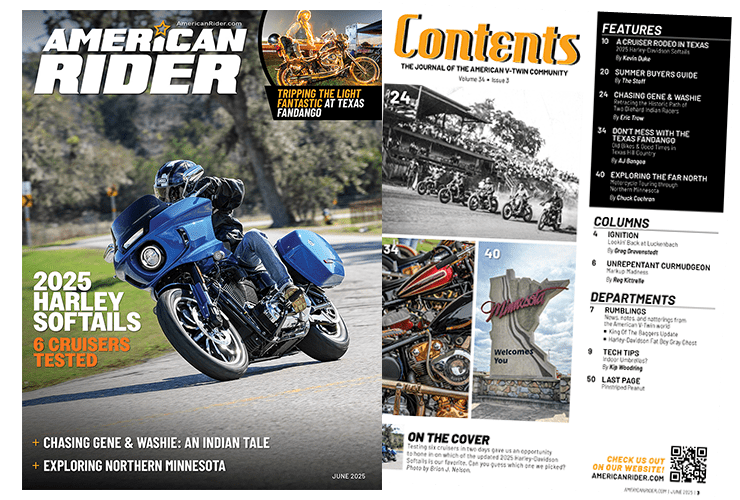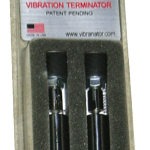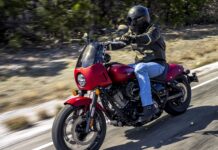The Vibranator
Vibranator LLC
$99.99
www.vibranator.com
888.425.1333
I must admit, I volunteered—or more properly, petitioned for—the opportunity to test the Vibranators. Now, when I tell you I ride a 2000 H-D Deuce you may think, “But PJ, that model comes with a counter-balanced ‘B’ engine; how much does it actually vibrate?” And that would be a fair question. But as many of us who love our late model Softails will testify, the counter-balancing element does a good job of minimizing vibration until the engine achieves somewhere in the range of 3,500 RPM. The thing is, I’m at that tender age when a little less vibration, especially on excursions of even moderate duration, would be greatly appreciated.
Because the Deuce comes without a tachometer and I haven’t had the heart to mess up the lines of his pull-back bars with a bolt-on, I’ll express his vibe tendencies in miles per hour. All things being equal in top gear, the right rear-view commences ghosting up at 73 mph and the images in the left one go all squiggly at 77 mph. At that point I usually back off the throttle until I’m doing 72, where the vibration in my grips pretty much subsides. Most riders I encounter think I’m a little crazy when I explain that one grip vibrates at a different speed than the other. But wait, there’s more. At 81 mph my left grip vibrates more intensely than the right. I know, I know, but the next time you’re in the saddle pay close attention to the vibration patterns in the grips of your Softail. Don’t be too surprised if you discover similar anomalies. Anyway, at 87 mph on up past 95 mph the vibration diminishes to the point where it’s discernible but not intolerable.
So, does my seeming hypersensitivity to vibration qualify me to road test an alleged vibration minimizing device? Hell yeah!
Don Richardson, the inventor/co-manufacturer of the Vibranator, has been a moving force in the development of motorcycle suspension components since he was a teenager. In fact, at the tender age of 19 he invented the Suzuki “Full Floater” suspension, enabling that company’s factory-sponsored riders to dominate the MX series. When I phoned and asked him how he came up with the idea for the Vibranator, he explained that though he loved to thrash around on his “thumper,” he found the bar buzz so annoying at certain RPMs that he was altering shift points to avoid the effect. Because Don is a helicopter pilot, he happened to hear about the technology a helicopter manufacturer, Eurocopter, employed to deal with excessive rotor head vibration. The mechanism is called a “tuned mass damper.” Similarly conceived structures are employed by architects to minimize a building’s vibration during an earthquake. He made a prototype that he adapted to respond radially instead of just up and down. He determined that if he could tune the spring and mass close enough to the resonant frequency of the bar it would disrupt the vibration rhythm. The idea was to eliminate “tonic vibration reflex” (the sustained contraction of a muscle subjected to vibration) in the hands and forearms, and alleviate numbness and tingling to the extent possible.
Don’s Henderson, Nevada-based company, which he co-owns with Brian Falter, not only offers models for different size handlebars but he also has two models for 1-inch bars. Chrome bars (magnetic), like those on my bike, have a slightly smaller interior dimension than 1-inch stainless steel bars (non-magnetic).
Because I had planned to have my mechanic Matt Sanna, owner of www. mobilecycleservice.com, drop by my house (he’s got a complete shop in a 16-foot trailer) and have him install something else, I figured, “What the hell, he’s gonna disassemble the switch housing at my throttle grip anyhow. Why not hold off on installing the Vibranators and have an actual mechanic give me his impressions of the procedure.” Matt glanced at the directions, quickly figured out the adjustment he needed to make, slid the mechanism into the handlebar, produced a 5mm hex wrench, inserted it into the hex bolt that tightens the rubber element that locks the thing in place, and reinstalled the grip. “So, Matt,” I queried, “was that as easy as it looked?” “Hell!” he replied, “there’s a chance even you could do it without screwing it up too bad.”
The road test
Hey! They work! No shit! They really work! Right from the git-go when I was warming up The Deuce I could feel a difference. Then when I accelerated into the “Vibe Zone” in top gear, I noticed that at 77 mph, there was significantly less mirror ghosting and only marginally discernible vibration in the grips. At 81 mph, where I typically experience the most vibration and ghosting, the amplitude of the ghosts appeared to be diminished by about half of normal and likewise the intensity of the vibration seemed to be 50 percent of what I’ve come to expect. Plus, at lower RPM I noticed even less vibration in zones where the counter-balancing element in the engine already does a good job of keeping them to a minimum.
I never imagined that a handlebar-mounted device would eliminate all the grip vibration that a pushrod V-Twin engine, even one equipped with a counter-balancer, could produce; so when I noticed that I could log somewhere in the range of 50 percent more saddle time before my right hand started to go numb, I decided that I could recommend the Vibranators with no reservations or qualifications.
Yeah, Don! Keep the good stuff comin’.



















